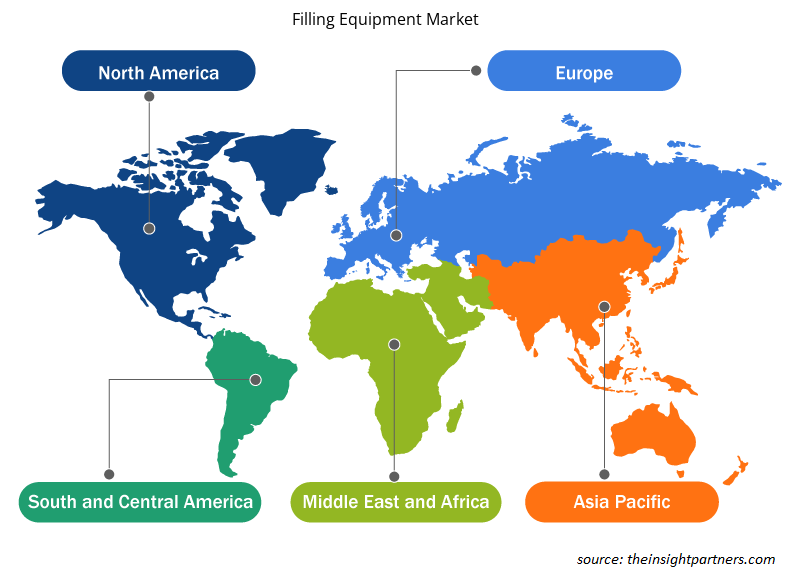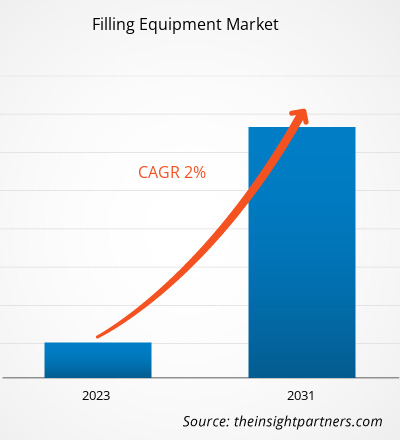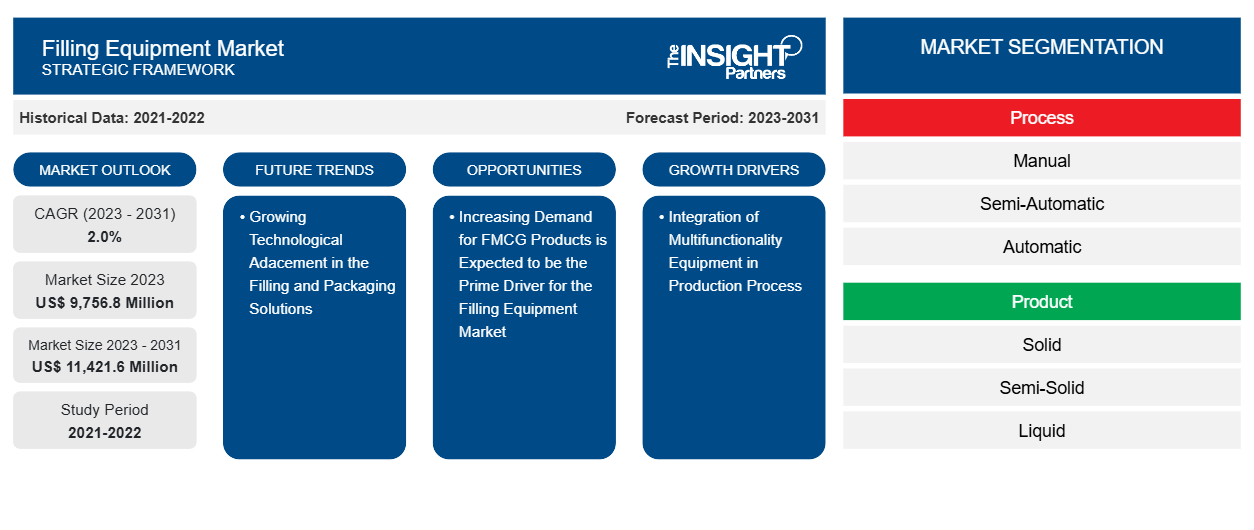من المتوقع أن يصل حجم سوق معدات التعبئة إلى 11.421.6 مليون دولار أمريكي بحلول عام 2031 من 9.756.8 مليون دولار أمريكي في عام 2023. ومن المتوقع أن يسجل السوق معدل نمو سنوي مركب بنسبة 2.0٪ في الفترة 2023-2031. ومن المتوقع أن يؤدي التطور الصناعي الكبير وارتفاع تكافؤ القدرة الشرائية للمستهلك والتبني المتزايد للتكنولوجيا الآلية إلى دفع نمو سوق معدات التعبئة خلال الفترة المتوقعة.
تحليل سوق معدات التعبئة
إن نتائج الإنتاج المطلوبة والدعم التكنولوجي المتقدم وأقل تدخل بشري وتكامل الأتمتة والروبوتات هي بعض العوامل الرئيسية التي تجذب انتباه الشركات المصنعة لاختيار معدات التعبئة. إن اللوائح الحكومية الصارمة لصناعة المشروبات والأغذية والصناعات المرتبطة بها تدفع منتجي آلات التعبئة إلى اختيار التوحيد القياسي من أجل تأكيد جودة المنتج والنظافة المطلوبة. علاوة على ذلك، من المتوقع أن يؤدي التركيز المتزايد للمستهلكين نحو المنتجات المصنعة والمعبأة المريحة، ونمو السكان، وزيادة الدخل، والتوسع الحضري المتزايد، والوعي الصحي إلى دفع الطلب على معدات التعبئة خلال فترة التنبؤ.
نظرة عامة على سوق معدات التعبئة
معدات التعبئة هي الآلات المستغلة لملء الأشكال الصلبة وشبه الصلبة والمسحوقة والسائلة للمنتجات في حاويات التخزين مثل الصناديق والأكياس والزجاجات أو الأكياس. يتم تصنيف السوق إلى عملية ومنتج ومستخدم نهائي وجغرافيا. بناءً على العملية، يتم تقسيم السوق إلى يدوي وشبه آلي وآلي. بناءً على المنتج، يتم تصنيف السوق إلى صلب وشبه صلب وسائل ومسحوق. من المتوقع أن يكون السائل هو القطاع الأسرع نموًا خلال فترة التنبؤ. على أساس المستخدم النهائي، يتم تقسيم السوق إلى الأدوية والأغذية والمشروبات ومستحضرات التجميل وغيرها. يعد الطلب المتزايد على معدات التعبئة في صناعة السلع الاستهلاكية سريعة الاستهلاك أحد العوامل الرئيسية الدافعة للسوق. ومع ذلك، فإن ارتفاع نفقات التركيب والصيانة قد يعيق نمو السوق في بعض التطبيقات.
قم بتخصيص هذا التقرير ليناسب متطلباتك
ستحصل على تخصيص لأي تقرير - مجانًا - بما في ذلك أجزاء من هذا التقرير، أو تحليل على مستوى الدولة، وحزمة بيانات Excel، بالإضافة إلى الاستفادة من العروض والخصومات الرائعة للشركات الناشئة والجامعات
-
احصل على أهم اتجاهات السوق الرئيسية لهذا التقرير.ستتضمن هذه العينة المجانية تحليلاً للبيانات، بدءًا من اتجاهات السوق وحتى التقديرات والتوقعات.
محركات وفرص سوق معدات التعبئة
من المتوقع أن يكون الطلب المتزايد على منتجات السلع الاستهلاكية سريعة الاستهلاك هو المحرك الرئيسي لسوق معدات التعبئة
من المتوقع أن يؤدي تطور صناعة السلع الاستهلاكية سريعة الحركة في الدول المتقدمة والنامية، بسبب العدد المتزايد من اللاعبين الجدد، إلى دفع الطلب على ملء سوق المعدات عالميًا. يخلق العدد المتزايد من مصنعي منتجات السلع الاستهلاكية سريعة الحركة في جميع أنحاء العالم طلبًا واسع النطاق على تقنيات التعبئة والتغليف، مما يعزز بدوره تطبيق سوق معدات التعبئة. أصبح التعبئة والتغليف جزءًا رئيسيًا من العلامات التجارية للمنتج. يستثمر المصنعون بشكل كبير في تقنيات التعبئة والتغليف القياسية للحفاظ على النظافة لمواكبة الإرشادات الحكومية. يُظهر تغليف المنتج دورًا حاسمًا لأنه يجذب انتباه المستهلك في المقام الأول نحو أي منتج. وبالتالي، فإن الانتشار المتزايد للعلامات التجارية للمنتج والتسويق، جنبًا إلى جنب مع التركيز على أتمتة العمليات لتحقيق كفاءة الوقت التشغيلي، يعمل كعوامل دافعة رئيسية لسوق معدات التعبئة.
التقدم التكنولوجي المتزايد في حلول التعبئة والتغليف
من المتوقع أن يوفر التركيز المتزايد على أتمتة العمليات والتقدم التكنولوجي المتزايد في حلول التعبئة والتغليف فرصًا كبيرة لمعدات التعبئة في مختلف الصناعات مثل الأغذية والمشروبات والأدوية والسلع الاستهلاكية سريعة الاستهلاك والمواد الكيميائية وغيرها. ومن المتوقع أيضًا أن يؤدي زيادة اعتماد إنترنت الأشياء والذكاء الاصطناعي وأنظمة مراقبة البيانات من قبل مصنعي المنتجات لتعزيز الكفاءة التشغيلية ووقت الإنتاج إلى دفع نمو سوق معدات التعبئة خلال الفترة المتوقعة.
تقرير تحليل تجزئة سوق معدات التعبئة
إن القطاعات الرئيسية التي ساهمت في اشتقاق تحليل سوق معدات التعبئة هي العملية والمنتجات والمستخدم النهائي.
- بناءً على العملية، تم تقسيم السوق إلى يدوي وشبه آلي وآلي. احتلت شريحة شبه آلية حصة سوقية أكبر في عام 2023.
- بناءً على المنتجات، تم تقسيم السوق إلى صلب وشبه صلب وسائل ومسحوق. احتل قطاع السوائل حصة سوقية أكبر في عام 2023.
- من حيث المستخدم النهائي، تم تقسيم السوق إلى قطاعات الأغذية والمشروبات والأدوية ومستحضرات التجميل وغيرها. وقد هيمن قطاع الأغذية والمشروبات على السوق في عام 2023.
تحليل حصة سوق معدات التعبئة حسب المنطقة الجغرافية
ينقسم النطاق الجغرافي لتقرير سوق معدات التعبئة بشكل أساسي إلى خمس مناطق: أمريكا الشمالية وأوروبا وآسيا والمحيط الهادئ والشرق الأوسط وأفريقيا وأمريكا الجنوبية.
سيطرت منطقة آسيا والمحيط الهادئ على سوق معدات التعبئة في عام 2023. تشمل منطقة آسيا والمحيط الهادئ الصين وأستراليا والهند واليابان وكوريا الجنوبية. من المتوقع أن يؤدي التطور العالي والانتشار المتزايد للتكنولوجيا المتقدمة، مثل معدات التعبئة شبه الآلية أو الآلية في مراكز تصنيع الأغذية والمشروبات والسلع الاستهلاكية سريعة التداول والمواد الكيميائية، إلى دفع نمو السوق خلال فترة التوقعات. يساهم الوجود العالي لمصنعي معدات التعبئة أيضًا في نمو سوق معدات التعبئة في منطقة آسيا والمحيط الهادئ. إن زيادة دخل الأسرة والتفضيل المتزايد لمستحضرات التجميل والأطعمة المصنعة يدعمان تطوير صناعات الأغذية والمشروبات والأدوية والسلع الاستهلاكية سريعة التداول في منطقة آسيا والمحيط الهادئ، مما يؤثر بدوره بشكل إيجابي على السوق في المنطقة. نظرًا لأن معدات التعبئة تلعب دورًا حاسمًا في عملية إنتاج المنتجات، فإن شركات التصنيع تركز بشكل كبير على دمج معدات التعبئة الراقية للحفاظ على النظافة والكفاءة التشغيلية. وبالتالي، من المتوقع أن يؤدي التركيز المتزايد على تطوير المنتجات الجديدة والتقدم التكنولوجي إلى دفع نمو السوق في منطقة آسيا والمحيط الهادئ.
رؤى إقليمية حول سوق معدات التعبئة
لقد قام المحللون في Insight Partners بشرح الاتجاهات والعوامل الإقليمية المؤثرة على سوق معدات التعبئة طوال فترة التوقعات بشكل شامل. يناقش هذا القسم أيضًا قطاعات سوق معدات التعبئة والجغرافيا في جميع أنحاء أمريكا الشمالية وأوروبا ومنطقة آسيا والمحيط الهادئ والشرق الأوسط وأفريقيا وأمريكا الجنوبية والوسطى.

- احصل على البيانات الإقليمية المحددة لسوق معدات التعبئة
نطاق تقرير سوق معدات التعبئة
| سمة التقرير | تفاصيل |
|---|---|
| حجم السوق في عام 2023 | 9,756.8 مليون دولار أمريكي |
| حجم السوق بحلول عام 2031 | 11,421.6 مليون دولار أمريكي |
| معدل النمو السنوي المركب العالمي (2023 - 2031) | 2.0% |
| البيانات التاريخية | 2021-2022 |
| فترة التنبؤ | 2023-2031 |
| القطاعات المغطاة |
حسب العملية
|
| المناطق والدول المغطاة |
أمريكا الشمالية
|
| قادة السوق وملفات تعريف الشركات الرئيسية |
|
كثافة اللاعبين في سوق معدات التعبئة: فهم تأثيرها على ديناميكيات الأعمال
يشهد سوق معدات التعبئة نموًا سريعًا، مدفوعًا بالطلب المتزايد من المستخدم النهائي بسبب عوامل مثل تفضيلات المستهلك المتطورة والتقدم التكنولوجي والوعي المتزايد بفوائد المنتج. ومع ارتفاع الطلب، تعمل الشركات على توسيع عروضها والابتكار لتلبية احتياجات المستهلكين والاستفادة من الاتجاهات الناشئة، مما يؤدي إلى زيادة نمو السوق.
تشير كثافة اللاعبين في السوق إلى توزيع الشركات أو المؤسسات العاملة في سوق أو صناعة معينة. وهي تشير إلى عدد المنافسين (اللاعبين في السوق) الموجودين في مساحة سوق معينة نسبة إلى حجمها أو قيمتها السوقية الإجمالية.
الشركات الرئيسية العاملة في سوق معدات التعبئة هي:
- شركة أكوتيك لمعدات التغليف المحدودة
- شركة كويسيا سبا
- مجموعة جي إي أيه أيه جي
- شركة جيه بي تي
- شركة كيه اتش اس المحدودة
إخلاء المسؤولية : الشركات المذكورة أعلاه ليست مرتبة بأي ترتيب معين.

- احصل على نظرة عامة على أهم اللاعبين الرئيسيين في سوق معدات التعبئة
أخبار سوق معدات التعبئة والتطورات الأخيرة
يتم تقييم سوق معدات التعبئة من خلال جمع البيانات النوعية والكمية بعد البحث الأولي والثانوي، والتي تتضمن منشورات الشركات المهمة وبيانات الجمعيات وقواعد البيانات. فيما يلي قائمة بالتطورات في سوق معدات التعبئة والاستراتيجيات:
- في يونيو 2021، أطلقت شركة ACMA، وهي جزء من شركة COESIA SpA، تقنية "Ecoshell"، وهي تقنية تغليف مستدامة تعتمد على الورق ومصممة خصيصًا لصناعة الحلويات. (المصدر: ACMA، بيان صحفي/موقع الشركة على الويب/النشرة الإخبارية)
- في مارس 2024، قدمت شركة GEA Group Aktiengesellschaft تطبيق ويب جديد مدفوع بالسحابة مخصص خصيصًا لمنتجات معالجة وتعبئة الأغذية في معرض Anuga FoodTec التجاري. (المصدر: GEA Group Aktiengesellschaft، بيان صحفي/موقع الشركة على الويب/النشرة الإخبارية)
تقرير سوق معدات التعبئة والتغطية والنتائج المتوقعة
يوفر تقرير "حجم سوق معدات التعبئة والتوقعات (2021-2031)" تحليلاً مفصلاً للسوق يغطي المجالات التالية:
- حجم السوق والتوقعات على المستويات العالمية والإقليمية والوطنية لجميع قطاعات السوق الرئيسية التي يغطيها النطاق
- ديناميكيات السوق مثل المحركات والقيود والفرص الرئيسية
- الاتجاهات المستقبلية الرئيسية
- تحليل مفصل لـ PEST
- تحليل السوق العالمي والإقليمي الذي يغطي اتجاهات السوق الرئيسية واللاعبين الرئيسيين واللوائح والتطورات الأخيرة في السوق
- تحليل المشهد الصناعي والمنافسة الذي يغطي تركيز السوق، وتحليل خريطة الحرارة، واللاعبين البارزين، والتطورات الأخيرة
- ملفات تعريف تفصيلية للشركة مع تحليل SWOT
- التحليل التاريخي (سنتان)، سنة الأساس، التوقعات (7 سنوات) مع معدل النمو السنوي المركب
- تحليل PEST و SWOT
- حجم السوق والقيمة / الحجم - عالمي، إقليمي، بلد
- الصناعة والمنافسة
- مجموعة بيانات إكسل
التقارير الحديثة
شهادات العملاء
سبب الشراء
- اتخاذ قرارات مدروسة
- فهم ديناميكيات السوق
- تحليل المنافسة
- رؤى العملاء
- توقعات السوق
- تخفيف المخاطر
- التخطيط الاستراتيجي
- مبررات الاستثمار
- تحديد الأسواق الناشئة
- تحسين استراتيجيات التسويق
- تعزيز الكفاءة التشغيلية
- مواكبة التوجهات التنظيمية























 احصل على عينة مجانية ل - سوق معدات التعبئة
احصل على عينة مجانية ل - سوق معدات التعبئة